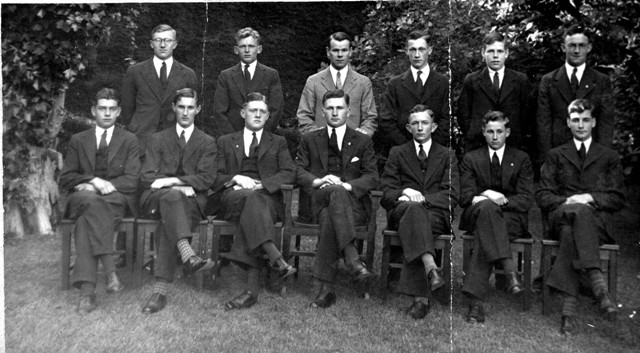HOUSE OF GUILDS  Wiki.jpg)
House of Guilds, circa 1950.
Originally established in 1935 as
‘a place where students and particularly boarders could pursue hobbies and crafts’ , the ‘House of Guilds’ followed the tradition of the craft guilds of the Middle Ages. The original building was a house on the corner of Talbot Street and Mercer Parade. The house was adapted for its purpose and received many gifts of materials and equipment through the generosity of friends of the College.
'Brighter School Experiment Succeeds at Geelong: Wonder House of Guilds', headlined the
Melbourne Herald of 1 April 1935. When the
Herald glowingly described the establishment of the Geelong College House of Guilds little did any realise that 70 years later many of the practices and activities of the original House would continue almost to the present day. In its modern guise the Austin Gray Centre is the familiar home of the School’s Creative Arts Program and a focus for community activity. From 1980 to 2010 the Austin Gray Centre included the House of Guilds. While no longer a “ 'Boys’ Club House” the Austin Gray Centre traces many of its activities to the original pioneering innovation of the House of Guilds established by the Rollands.
Purchased in late 1934, and established in a large rambling 13 room house on the corner of Talbot St and Mercer St where the Neil Campbell Tennis Courts are now sited, the House of Guilds was Francis Rolland’s answer to the persistent challenge of providing an educational choice for his students, and especially boarders, during their leisure time. Conceived as an entirely voluntary, self managing, co-operative with its own student led governing Council, the House of Guilds was far more than simply a place where students could pursue activities, crafts and hobbies. In Rolland’s own words it was established 'to give the schoolboy facilities for the expression of his natural, inherent talents and ideas which, in the classroom would probably lie dormant, repressed and undeveloped'. The
Herald went on to report that by painting the doors to the Guild Council Room bright red, Rolland had shown his dissatisfaction with
'the dull brown of the average school curriculum' .
Nevertheless, the House of Guilds was very much a child of its times. It represented a positive reaction to the widespread futility of the Great Depression and indicated a growing optimism and determination to improve not only the choices students had but also to
'improve' those very students. A brochure published shortly after its first opening in April 1935 describes how 'the Principal and Mrs Rolland, during the long vacation, planned and supervised the entire renovation of the old house. Each room was to be furnished, even to the designs on the curtains, to suit the nature of the Club it sheltered. The result has been a unique Boys’ Club House.' Economic well-being was returning to the School enabling opportunities for change, and 1935 in particular, signalled a series of initiatives including the foundation of the new music and drama program. The south wing of the Cloisters was completed the preceding year and, in 1936, the College was to joyously win its first Head of the River. It was an enervating period.
 Wiki.jpg)
Plan of the original House of Guilds.
In February, 1935, the Arts and Crafts Master, Mr John Bechervaise was installed as the first Warden of the then House of Guilds to be followed by Don Webb from 1939 to 1943 and 1949 to 1972. John Bechervaise returned between 1944 and 1948. Leonard E Errey was the first student Guild Leader and Arthur B. Simson, Chief Recorder. The House assigned rooms or areas in its grounds to its activities. These activities included Crafts such as Leatherwork, and Woodwork, Modelling and Engineering, Pottery, Radio, Photography, Printing, Bookbinding, Collecting and Display, and Horticulture. The House also provided a base for outdoor activity including the home of the Ramblers Club.
With the rapid changes in curriculum through the 1960s and 70s together with the relative rise in the numbers of day students many of the activities of the House tended to became either more mainstream or redundant. With the construction and opening of the new Austin Gray Centre in 1980 amidst the buildings of the original Preparatory School, the acceptance of the original concept became complete, though perhaps ironically, and contrary to Rolland’s ideas, also institutionalised.
The old house was used as a maintenance store, became dilapidated and unloved and eventually was demolished. The store shed succumbed to fire. Sadly, its passing took much of the physical evidence of a courageous initiative in education and many of the artefacts accumulated by the School over the years. Fortunately, many of the projects and artefacts created by students survive in the College’s archival Collection including examples of commercial printing and the minutes of the Guild Council. Many items continue to grace the homes of former students and their descendants. Ultimately, it is the activities of the students themselves which are the great legacy of the House of Guilds.
House of Guilds Wardens:
First House of Guilds Council, 1935.
1935-1936 Bechervaise, J
1937-1938 Radcliffe, R. E.
1939-1943 Webb, D.
1944-1944 Westbrook, S. H.
1945-1949 Bechervaise, J.
1949-1972 Webb,D.
1974-1990 Elliott, F. W.
1991-2011 Taylor, P.